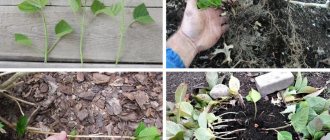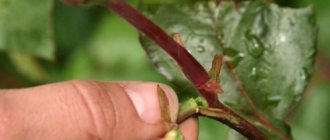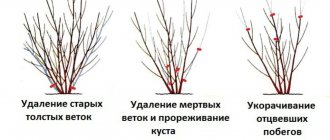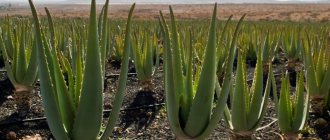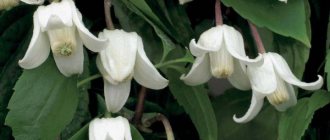Advantages and disadvantages of autumn cuttings
The formation of clematis bushes occurs in the fall. Pruning is mandatory for this type of plant. This improves development and growth, promotes the spring awakening of the buds. During shaping, many branches remain; they are cut into petioles, which can be used for planting and propagating plants.
Benefits of planting in autumn:
- plants harden and get used to temperature changes;
- autumn seedlings outstrip spring bushes in growth;
- in rainy times there is no need to waste water for irrigation;
- In the fall, gardeners have more free time for pruning than in the spring, when massive work is underway.
In the spring, the branches have not yet grown back after the autumn pruning; you can overdo it with pruning. In addition, in the spring the buds swell and the sap moves along the branches. At such a time, it is better not to disturb the vine.
The disadvantage of autumn cuttings is that you may not predict early frosts, and the seedlings will freeze before they have time to take root. It is more difficult for cuttings to take root in autumn than in summer. In the summer, they are rich in biostimulants; they stimulate the appearance of buds.
Methods for propagating clematis
Clematis rarely produce seeds; the seed method is labor-intensive and rarely produces seedlings. If the seeds take root, the bush still loses its maternal properties. Clematis can be propagated in several ways. The most common is the method of cutting cuttings from clemis.
Cuttings of clematis in autumn
To propagate clematis by cuttings in the fall, you need bushes 3-4 years old. After pruning the bush, choose strong, healthy branches. It is better not to use tops with buds. Cut the middle part of the shoot without buds, but with 2 nodes and a couple of buds at the base of the leaves. For pruning, use a sharp knife or pruning shears; it is better to work with gloves. Growing clematis from cuttings is a simple method of propagation, but it will take more than one year of the plant’s life to wait for abundant flowering.
Reproduction of clematis by layering
In May or early summer, 2-3 long, healthy shoots are selected from the bush. Place them in small grooves to a depth of 8 cm; you can secure them with a hook or clothespin so that the shoot does not bend. When watering the bush, the place of the cuttings is watered abundantly. When the shoots grow to 15 cm in length, the ground around is covered with mulch. By autumn, new plants can be replanted.
In mid-autumn, all leaves and part of the shoot up to the first developed bud are removed from the pruned branches. The branches are tied and placed in dug grooves. A layer of peat is poured onto the bottom of the holes and on top of the shoots; the material retains moisture and is breathable. Fill the ditch with earth and compact it. In spring, this place is well watered and fed with mineral supplements. When seedlings appear, the soil is mulched with moss and humus. Next fall, the plants are planted on the site.
Hilling method
In the summer you can grow cuttings for autumn planting. To do this, in June a box without a bottom or top is placed on the growing branches. Add soil regularly until the structure is completely filled. The part of the branch with two developed buds should remain uncovered. During this procedure, the soil is watered abundantly. By autumn the cuttings will be ready for planting. Cut the shoots at a height of 20 cm from the ground. Spud the bush around the bush with nutritious soil 15 cm high and cover it with insulation for the winter.
Dividing the bush
Autumn division is safer than spring division. You cannot dig up a plant when the buds have begun to awaken and the bush has begun to develop.
Divide five-year-old clematis into small bushes. The bush is dug out of the ground and shaken off. The rhizome of an adult plant is powerful and long; bushes often have to be undermined. The entire root is washed in water to see where to separate. Carefully separate into several bushes. All shoots are cut back to the second buds and planted in a new location.
You may be interested in:
Planting and caring for tree peony in open ground It seems that no one needs to be told how beautiful and fragrant the peony is. Many summer residents...Read more...
Attention!
Clematis does not tolerate root trauma well, so it is better to use this method as a last resort.
Reproduction in water
The same process of cuttings, only the roots are placed in water until roots appear. To transplant young plants in September, you need to cut off the branches and put them in water around July. The leaves are left, only those that are in the water are removed. Immerse part of the shoot so that one internode is in the liquid. Do not place the container in the light; if this is not possible, then wrap the container in paper. At room temperature, roots will appear in 30-40 days. When the roots are 5-6 cm long, the seedlings are transferred to greenhouse soil. You cannot keep the roots in water - they will get tangled and the buds will dry out.
Useful tips from experienced gardeners
Regardless of the chosen method of propagating clematis, it is important to adhere to certain rules:
- the optimal temperature for rooting cuttings is from 10 to 20 oC;
- if possible, install a fogging device next to the propagated shoots;
- when dividing the bush, the roots that are too long are shortened by a quarter of the total length, and the cut areas are slightly dried and treated with a highly concentrated solution of potassium permanganate;
- To quickly restore a divided plant, it is recommended to water it with any nutrient mixture;
- To protect young clematis from rodents and slugs, place a tablet of the drug “Storm” nearby or scatter Metaldehyde granules.
In the absence of relevant experience in terms of propagating clematis, it is better not to choose the method with seeds and grafting.
Features of autumn breeding
Proper pruning of branches, trimming petioles, their care and soil influence the further development of clemitis. Incorrect cutting or excessive watering can destroy the young growth.
Preparation of cuttings
It is better to trim cuttings during the period of bud formation. Basically this is the end of spring - beginning of summer.
Sequence of cutting cuttings:
- the cut is made over 1-2 sheets;
- take the middle part of the branch;
- cut at an angle of 45 degrees 5 cm below the first node and 2-3 cm above the second node;
- large leaves are removed;
- place 1/3 of the petiole in water;
- shoots are placed in a dark place for 9 hours in a growth stimulator: rootin, sodium humate, heteroauxin;
- then wash the branches under running water.
Soil preparation
Clematis prefers an alkaline habitat. Soil with high acidity is limed. Prepare light, moisture-absorbing and breathable soil:
- The composition used is: sand, humus, peat (1:1:1).
- A mixture of river sand and sphagnum moss.
- Garden soil, peat, humus 1 part, 0.5 part sand, 20 g superphosphate per 5 kg of mixture.
- You can root petioles in coconut fiber, perlite, and vermiculite.
Attention!
Any soil mixture must be filled with a solution of potassium permanganate for disinfection - 4 g of the substance per 9 liters of water.
Planting and caring for cuttings
To achieve abundant flowering, you should not plant clematis in a sunny place, it is better to choose partial shade. Do not plant the plant near an iron fence or near the walls of a house. Water from the roofs should not flood the bushes. Do not grow vines in drafts and windy areas.
To root woody cuttings, seedlings of low-flowering and wild varieties are taken. The branches are cut in August, 8-12 cm long with two nodes. After the shoots take root in the water, they are planted in boxes for rooting. The lower part of the petiole is deepened by 3 cm. To keep the buds from drying out, the node is deepened by 1 cm. The distance between seedlings is 6 cm, and between rows is 15 cm.
To actively grow the root system, you need care for clematis:
- temperature in the room is 19-22 degrees;
- For the first three weeks, the plants are watered a little daily, then once every 10 days is enough;
- seedlings need high humidity, they are sprayed 3 times a month;
- regular ventilation of the room;
- Once every 8 days, the petioles are sprayed with zircon, a plant growth regulator.
- After rooting the cuttings, the film is removed, they are picked in the spring, and planted in the garden in the fall.
Attention!
Air temperatures above 30 degrees are detrimental to young animals.
Properly prepared soil substrate
Green cuttings of clematis require preparation of the soil substrate. You should not plant the “cubs” in purchased land, as it is not entirely suitable for them. Professionals recommend preparing two-layer soil:
- The top layer is clean river sand, which has been disinfected.
- Lower - equal amounts of sand, black soil and peat.
The soil, which will be the bottom layer, is thoroughly mixed until all components are evenly distributed. Peat must be of low acidity.
When studying the question of how to cut clematis in the summer, you should pay special attention to the section on soil, since a lot depends on it. Tender clematis is susceptible to fungal infection, the spores of which develop in the soil
That is why before planting a bush, it is necessary to carry out disinfection. Use a solution of manganese, phytosporin or foundationol. In addition, the soil should be loose and well breathable.
How to root a shoot
You can grow clematis cuttings in greenhouses, greenhouses, tunnels and in boxes on window sills. If bushes are pruned in the fall, the cuttings must first be rooted and planted in the ground in the spring. There are several ways to grow petioles.
Plastic cups
In a transparent plastic glass you can clearly see what is happening to the roots of the plants. Application of cups:
- covered with nutrient mixture;
- small holes are made in the container for drainage;
- water the ground;
- dig in the petiole so that the node is half covered with soil;
- Before the cuttings root, cover the glasses with film.
When the time comes to plant plants from cups, the seedlings are transferred to the hole along with the soil in which they grew.
You may be interested in:
Propagation of chrysanthemums in autumn: cutting method Cuttings are one of the most effective ways of propagating garden chrysanthemums. The main advantage of the method…Read more…
The soil
The petioles are planted in the soil mixture in a film greenhouse. A cardboard box is dug into the ground. The soil must be clean of weeds and harmful microorganisms. It is better to make the soil two-layer. The first layer - pour peat and sand for drainage with the addition of humus, cover everything with sand on top. Spill with manganese solution. For rapid rooting, seedlings are treated with heteroauxin or sodium 2 g per liter of water for 8-10 hours, washed, and transferred to the soil.
Water
Use a wide-necked container for rooting shoots. Pour water, immerse the twigs so that only the ends are 1 cm immersed in the liquid. The container is placed in a dark place. As the water evaporates, it is added to the previous level. When the rhizome is 4-5 cm, the shoot is planted in a greenhouse.
Bottles
Resourceful gardeners have come up with a way to root flowers using two-liter plastic bottles. At the same time, space is saved and cuttings take root faster.
The bottle is cut in half. An earthen mixture is poured into its lower part, the seedling is deepened, watered from above, and covered with the second part of the bottle. The joining place is connected with tape, the plug is closed. The mini greenhouse is buried in the ground to the level of the soil in the bottle. After a couple of weeks, the greenhouse is ventilated - the plug is unscrewed for half an hour a day. When shoots appear, the bottle is left open and drainage holes are made.
In addition to bottles and cups, plastic bags, pots, and containers are used. Mostly these containers are located in flower beds or greenhouses.
Conditions for rooting cuttings in the substrate
In clematis that bloom on last year's branches, cuttings begin before flowering in May or in July after flowering. In mid-summer, green petioles are planted in pots, boxes or directly into open ground. At the end of August, vine shoots are cut and healthy shoots are rooted only in closed ground.
Prepared shoots can be immediately planted in fertile soil:
- Individually - cups, bottles, pots.
- Planting in a common cuttings - in this case it will not be possible to monitor the rooting process. The soil is made in two layers: first 20-25 cm of substrate, then 5 cm of perlite or sand. The earth is leveled, compacted and moistened.
Soil preparation
In order for the result of clematis cuttings to be the appearance of a new flowering crop in the garden, it is worth paying attention to the preparation of the soil or a special soil mixture for rooting the planting material. The first layer in this case will consist entirely of disinfected river sand
The next bottom layer will be a mixture consisting of peat, black soil and sand in equal quantities. Low acidity peat is a priority; all components must be well mixed together.
The first layer in this case will consist entirely of disinfected river sand. The next bottom layer will be a mixture consisting of peat, black soil and sand in equal quantities. Low acidity peat is a priority; all components must be well mixed together.
Clematis is distinguished by its low resistance to fungal infections, so it is worth disinfecting not only river sand, but also all other components. For these purposes, you can use a weak solution of manganese, Fitosporin or Fundazol.
The cuttings can be planted in special containers, the depth of which will be no more than 30 centimeters. The layers must be equal in thickness. Some gardeners prefer to propagate clematis in bottles.

